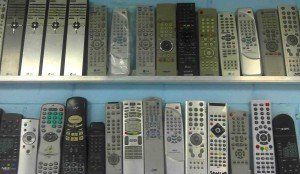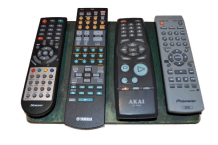The recent passing of Eugene Polley, the man known for inventing the remote control, has given me cause to reflect on the development of the remote control. In just my life time, the humble TV remote control has come into existence and been developed rapidly.
Introducing the Flash-Matic Remote Control
Eugene Polley worked for American firm Zenith Radio Corporation (now owned by LG). In 1955 he invented the Flash-Matic, a light beam which was aimed at one of four different light sensors around the TV screen. It was possible to turn the TV on and off, and change channels. The 1956 ad for this ground breaking invention is reproduced below.  I like the line about it being “Absolutely harmless to humans!” It has been reported that this early system did have some problems in bright lights. However it is the forefather of the modern remote control which we now take for granted.
I like the line about it being “Absolutely harmless to humans!” It has been reported that this early system did have some problems in bright lights. However it is the forefather of the modern remote control which we now take for granted.
Introducing the Computermatic Remote Control
Early B&W and Colour TVs used a large channel knob to change channels. This required actually getting out of your chair to change channels (and to adjust the volume too).  Therefore it was exciting to visit my grandparents house as they had a “computermatic” TV. This 1962 TV used a motor to rotate the channel changer. It also used a wired remote control, similar to the picture. Although there was a lead between the TV and the operator, it did allow remote control of the sound, picture (brightness) and the ability to change channels from the lounge chair. The channel button on the TV and the remote were labelled “FWD” and “REV”, as the motor rotated in the forward or reverse direction to change channels. This remote control also had a feature modern remote controls don’t have. Built into the remote control was a small speaker. The slide switch at the bottom of the remote control allowed the sound to come from the TV (receiver), the remote speaker, or to mute the sound. This allowed a young Geoff to watch and listen to TV when everyone else was in bed – without disturbing them. The other good thing about this wired remote control is that it was hard to loose down the side of the lounge – you simply followed the lead to find it. It also did not require batteries!
Therefore it was exciting to visit my grandparents house as they had a “computermatic” TV. This 1962 TV used a motor to rotate the channel changer. It also used a wired remote control, similar to the picture. Although there was a lead between the TV and the operator, it did allow remote control of the sound, picture (brightness) and the ability to change channels from the lounge chair. The channel button on the TV and the remote were labelled “FWD” and “REV”, as the motor rotated in the forward or reverse direction to change channels. This remote control also had a feature modern remote controls don’t have. Built into the remote control was a small speaker. The slide switch at the bottom of the remote control allowed the sound to come from the TV (receiver), the remote speaker, or to mute the sound. This allowed a young Geoff to watch and listen to TV when everyone else was in bed – without disturbing them. The other good thing about this wired remote control is that it was hard to loose down the side of the lounge – you simply followed the lead to find it. It also did not require batteries!
Wired Remote Controls
 Wired remote controls became popular with many early Video Cassette Recorders (VCRs) . These wired remote controls allowed some tape playback control, mainly play/pause along with fast forward and review.
Wired remote controls became popular with many early Video Cassette Recorders (VCRs) . These wired remote controls allowed some tape playback control, mainly play/pause along with fast forward and review.
I recall around this era making a remote volume control and adapting our family TV to enable this volume control to adjust the TV sound – via a wire of course. But hey, this was a huge leap in interactive technology at our home, and the envy of many friends – fancy not having to get up to adjust the volume of the TV!
A good thing about these wired remote controls is that they were duplicating the controls on the front panel of the VCR, not replacing them. All functions could be easily controlled from the VCR even if the remote control was not lost or not working.
Cordless Remote Controls
 The cheap availability of electronic tuners in TVs (and VCRs) made easy (and cheap) remote channel selection possible. This spawned the era of the common cordless remote control. So common, it seems every piece of home entertainment equipment needs its own remote control.
The cheap availability of electronic tuners in TVs (and VCRs) made easy (and cheap) remote channel selection possible. This spawned the era of the common cordless remote control. So common, it seems every piece of home entertainment equipment needs its own remote control.
Apart from making you lazy by not having to get up to adjust the TV, these remote controls have raised several other issues. Not the least being many devices now rely on the remote control. If the remote control stops working or is lost, it is almost impossible to use most functions on the device.
Another issue is the problem of having to have a different remote control for each device. While universal remote controls are available, they don’t suit everyone, and can be more complicated to use, and they don’t always allow every function of the original remote control.
Taming the Remote Controls
A simple method to help manage several remote controls is to mount them on a board (a custom made board or a chopping board works well). Having all your remote controls mounted on the one board has several advantages:
- as the remote controls are always in the same order it is easy to know which one to use for each device.
- because they are in the same position, you quickly learn which button to press for each function.
- they are always facing the same direction so you don’t need to turn each remote around to point it in the correct direction
- a board is harder to loose down the side of the lounge
The Best New Feature
In my opinion the best new feature since the introduction of remote controls is shown in this picture. It is the little plastic tether strap which connects the battery cover to body of the remote control. This prevents the battery cover from being lost misplaced. Why wasn’t this thought of years ago?
Please leave your thoughts on the pros and cons of remote controls in the comment section below.

